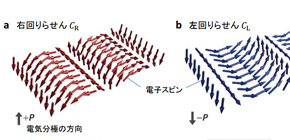
Advanced Memory Storage through Light-induced Switching of Antiferromagnetic Domains
International research team centered at Osaka University realizes breakthrough in antiferromagnetism control using laser irradiation
Using light to control the magnetic properties of materials is attractive for applications such as memory. Antiferromagnetic materials display magnetism resulting from the opposing alignment of the spins of atoms on different sublattices. Antiferromagnetic materials have attracted interest because their magnetic properties are highly stable and not affected by stray magnetic fields, which may make them suitable for use in information processing and data storage. However, it is difficult to control the spin structures of such materials. Now, an international team of researchers centered at Osaka University has for the first time demonstrated optical control of antiferromagnetism. The researchers controlled the magnetic structure in the antiferromagnetic material terbium manganite (TbMnO 3 ) using light pulses of two different wavelengths, which caused the antiferromagnetic domains of TbMnO 3 to switch.
“The antiferromagnetic order parameter of terbium manganite can be reversibly switched by 180 degrees upon exposure to laser beams of two different colors,” Tsuyoshi Kimura, professor at the Graduate School of Engineering Science, Osaka University explains.
Domains in TbMnO 3 with different antiferromagnetic order parameters were identified non-invasively with high resolution by an optical imaging technique. Irradiating TbMnO 3 with the light of different wavelengths induced switching of the antiferromagnetic order parameter of domains. Such switching was stable for at least 5 days. Laser irradiation of the domains raised their temperature above the antiferromagnetic transition temperature of TbMnO 3 . When the laser was removed, the sample cooled and then antiferromagnetic and electric polarization order re-established. The electric polarization induced the antiferromagnetic domain switching, resembling the behavior of ferroelectric materials.
“The reversible optical control of antiferromagnetic domains is important because it may lead to development of electronic circuits that can be written and erased,” Kimura says.
Write–erase cycling of the antiferromagnetic domains on a TbMnO 3 surface was conducted by carefully modulated laser exposure. Localized, reversible optically driven switching to a controlled depth for 200 cycles was achieved, and line patterns were formed without interference. These results represent an advance in the ability to control the magnetic behavior of materials through interaction with light.
Abstract
Lasers can be used to control the magnetization of a ferromagnet via optically driven thermal and electronic excitation. Transfer of this concept to antiferromagnets is appealing because of the increasing technological interest in antiferromagnetism. Controlling spin structures in antiferromagnets is challenging, however, because of their zero magnetization. In a proof-of-principle experiment we demonstrate that optical control of antiferromagnetic domains is nevertheless possible. We reverse the antiferromagnetic order parameter in multiferroic TbMnO 3 repeatedly, using light pulses of two different colours. Switching depends on a unique relation between the wavelength of the light, its optical absorption and the electric polarization field induced by the antiferromagnetic order of TbMnO 3 . We then demonstrate sequential laser-controlled writing and erasure of antiferromagnetic domains. The universality of reversible optical antiferromagnetic switching is derived by Monte Carlo simulations. Opto-magnetism is thus complemented by an important degree of freedom, namely local control of antiferromagnetism by means of light.

Figure 1. Right- and left-handed spin spiral structures in multiferroic TbMnO 3

Figure 2. Reversal of the handedness of spin spiral structure by light irradiation

Figure 3. Reversible switching of the handedness of spin spiral structure by light irradiation
To learn more about this research, please view the full research report entitled “ Reversible optical switching of antiferromagnetism in TbMnO 3 ” at this page of the Nature Photonics website.
Related link
